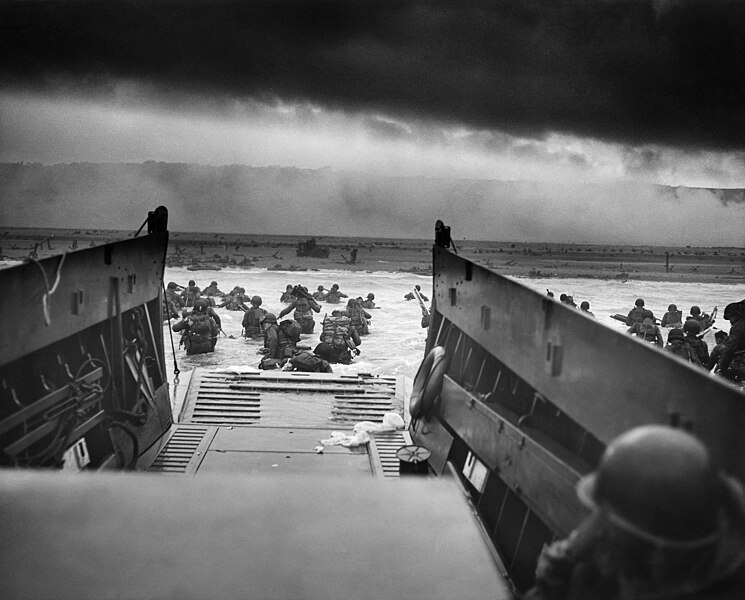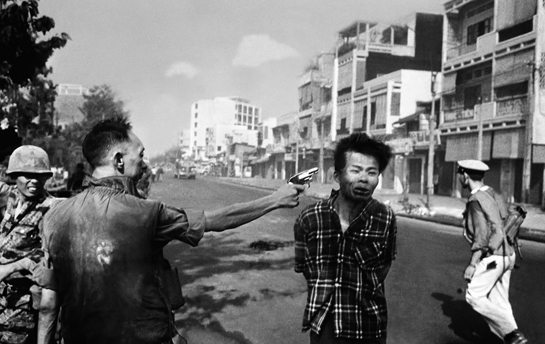Photojournalism
Photojournalism is the practice of illustrating prints and newstories to create more of an effect towards the reader. This became possible with the original engravings in the late 1880's, but only became well-known and used by the majority and newspapers/magazines in the early 1930's when photojournalism hit it's "golden age".
Photojournalism instantly became a tool of great power, this innovative new technique brought the readers something more than words. It was able to invoke and create powerful emotions otherwise left untouched by words.
"We photographers deal in things which are continually vanishing, and when they have vanished there is no contrivance on earth can make them come back again. We cannot develop and print a memory" - Henri Cartier-Bresson.
Henri Cartier-Bresson was a French photographer who was considered to be "The Godfather" of photojournalism. He was one of the first people to use the 35mm format, and was claimed to be the master of candid photography (A candid photograph is a photograph where the people in the photograph have not given consent nor realise that they are being photographed - this allowed him to take shots which were closer to reality). His career only took a serious change in 1930's, when he switched over from painting, to photography. He was inspired by Hungarian photojournalist Martin Munkacsi - who took pictures of 3 african children, after Henri saw this, he took his camera to the streets.
As being a well-known artist, Henri Cartier-Bresson made enough money to efford & was known for using only one camera, a Leica rangefinder, and one lens, a 50mm, for almost all of his life's work.
Henri Cartier-Bresson was a French photographer who was considered to be "The Godfather" of photojournalism. He was one of the first people to use the 35mm format, and was claimed to be the master of candid photography (A candid photograph is a photograph where the people in the photograph have not given consent nor realise that they are being photographed - this allowed him to take shots which were closer to reality). His career only took a serious change in 1930's, when he switched over from painting, to photography. He was inspired by Hungarian photojournalist Martin Munkacsi - who took pictures of 3 african children, after Henri saw this, he took his camera to the streets.
As being a well-known artist, Henri Cartier-Bresson made enough money to efford & was known for using only one camera, a Leica rangefinder, and one lens, a 50mm, for almost all of his life's work.
As World War II came around during the 1939 - Early 1940's photography had a big impact to readers at home, and photojournalism became even more important and renown. The two key photographers during World War II were Robert Capa (Hungarian Combat photographer who shot the photo above) and Tony Vaccaro (American photographer/soldier who shot the photo below)
Whilst both of the photographers above became very famous; each of them differed in what that were able to show in their work.
Robert Capa worked for Life magazine at the time, and wasn't tied down to being a photojournalist and a soldier. He was able to go in and out of battles at his will, and in more of a safe environment than Tony Vacarro.
Tony Vacarro was a scout GI for the U.S Army, and a soldier. His photos were censored by the army - and showed possibly what has been called a "closer-view" of reality than what Robert Capa's photos were able to show.
Capa was also able to efford the Leica; a lightweight fast camera. This allowed him to move more freely - and shoot photo's easier. Whilst Vacarro was given the standard Speed Grafic camera by the military, he upgraded to the Arga C3 (which was still a heavy-weight camera slower than Capa's, but it was still better than the Speed Grafic).
As the war finished Vacarro became a photographer for many U.S Magazines and was given many awards.
Lastly I'm going to cover Eddie Adams (who took the photo above). He was a 'Pullitzer' prize winning photographer and photojournalist who shot photographs and images of 13 wars in total.
Arguably his most iconic and 'best' photo was the one above; the execution of a Vietcong general during the Vietnam war. This photo was one of, if not, the most powerful photo of the Vietnam war. Writer and critic David D. Perlmutter points out that 'no film footage did as much damage as AP photographer Eddie Adams's 35mm shot taken on a Saigon street ... When people talk or write about the Tet Offensive (the war movement at the time) at least a sentence is devoted (often with an illustration) to the Eddie Adams picture'.
Whilst there is film footage of this particular scene, nothing quite compares to the photo, capturing in an instant the emotion of this split second in history; and having quite a large impact on the war itself.
Photography & photojournalism has its problems with validity and reliability. In the case of Eddie Adams, his photo, which was so emotionally powerful had even a part to play in America pulling out of the Vietnam war. Where are the video footage of this specific moment actually has more reliability and validity, as it shows more angles, for a longer period of time. The photographer has the chance to capture something which I think is deeper than that, photography can have a huge impact - it adds emotion behind what words can describe.
The power of photographs also comes huge responsibility, the photographer can capture the one specific angle - in this he shows what could be called a 'biased' viewpoint of the whole scene; comparatively - like an argument, hearing just a few words of the whole argument can give people views and opinions on it without actually having full understanding.
With 'Modern' day technology, there are even more powerful techniques for editing, or bending the truth. Photoshop (first versions released in 1988) allowed the manipulation of images - and therefore the manipulation of the truth.
Brian Walski, a staff photographer for the L.A times who was covering the war in Iraq (and show the images above, and edited the manipulated image) was like Eddie Adams and had the capability to manipulate points of view and show what he wanted; every photographer has this power. He took it a step further, and actually manipulated the image after it was taken, now - I do believe this has negative and positive aspects.
On the positives; it can give morale to troops - for example editing out of America soldiers being hurt in a warscene. I believe there is a very fine line between too much, and it being a good tool for the media. Manipulation is usually made in the fashion world, and portraiture world to make things look better than they do in reality, this has positives and negatives also.
The negative aspects are vastly to do with the fact we are responsible for showing the truth, lying to our nation through mass media is a controlling mechanism, and manipulating images is a great way for doing that (propaganda).
To conclude, I think photojournalism is extremely important. However, I do think there is a very fine line that needs to be trod very carefully when it comes between truth and manipulation.
Robert Capa - 1913 - 1954
Robert Capa was a Hungarian combat photographer and photojournalist who covered five different wars: the Spanish Civil War, the Second Sino-Japanese War, World War II across Europe, the 1948 Arab-Israeli War, and the First Indochina War. He documented the course of World War II in London, North Africa, Italy, the Battle of Normandy on Omaha Beach and the liberation of Paris. His action photographs, such as those taken during the 1944 Normandy invasion, portray the violence of war with unique impact. In 1947, Capa co-founded Magnum Photos with, among others, the French photographer Henri Cartier-Bresson. The organization was the first cooperative agency for worldwide freelance photographers.
He used the newely released Leica; this allowed photography- and photojournalism to reach a new height.
Capa's motto was "get close, get closer" - unlike Tony Vaccaro his images were not censored by the army, he worked for Life magazine.
Tony Vaccaro - 1922 - present
Tony Vaccaro is an American photographer who is best known for his photos taken in Europe during 1944 and 1945 and in Germany immediately after World War II. After the war, he became a renowned fashion and lifestyle photographer for U.S. magazines.
Unlike Robert Capa, Tony Vaccaro was a soldier photographer; making it hard for him to get in and out to different battles like Capa could.. however it has been said that he was able to get closer than Capa.
Henri Cartier-Bresson - 1908 - 2004
Henri Cartier-Bresson was a French photographer considered to be the father of modern photojournalism. He was an early adopter of 35 mm format, and the master of candid photography (A candid photograph is a photograph that is made either without the subject's knowledge or without their explicit permission, hence they are captured unposed) He helped develop the "street photography" or "life reportage" style that has influenced generations of photographers who followed.














